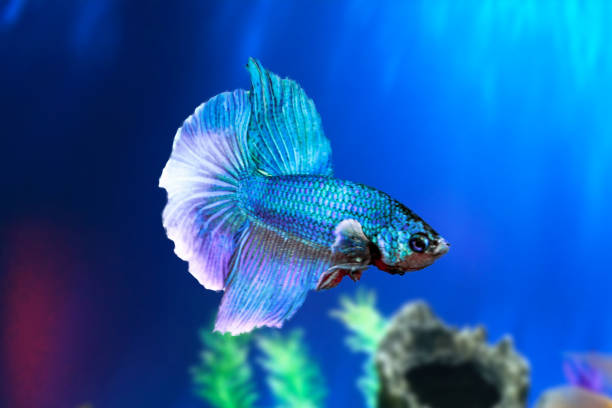Why Is My Betta Fish Tail Bent: Causes, Symptoms, Treatment, and Prevention
Betta fish are known for their beautiful tails, but many betta fish owners notice that their betta fish tails are bent. What’s causing this?
Betta fish tails can often be curved or bent due to a variety of reasons. One common cause is improper water quality, as poor water can lead to stunted growth and curvature in the fish’s tail. Additionally, the cause of betta fish tail bending is usually a result of fighting or stress in the home aquarium, so it’s important to take your betta fish to a qualified vet if it appears to be in pain or has other abnormalities.

Table of Contents
Common Causes Why Betta Fish Tail Is Bent
Fish Tuberculosis
Fish tuberculosis is a bacterial infection that can affect both freshwater and saltwater fish. It is most commonly found in bettas, but can also affect other types of fish. Fish tuberculosis is caused by the bacterium Mycobacterium marinum, which is spread through contact with infected water. Symptoms of fish tuberculosis include coughing, difficulty breathing, and lethargy. Treatment typically involves antibiotics administered through feed or water. Prevention of fish tuberculosis involves keeping infected water and feces out of the aquarium and treating sick fish promptly with antibiotics.
Bettas’ spine and tail may bend because of tuberculosis. When the spines are bent, it can make the fish less able to swim and escape predators. Bettas with tuberculosis often have other symptoms as well, such as poor appetite and decreased inactivity. If you see your fish having any of these symptoms, it is important to take him to the vet for an examination.
Capturing Accidents
When a person captures a betta fish, the fish’s natural environment is suddenly changed. The betta fish may feel scared and stressed because of the sudden change in pressure. This can lead to a rapid change in the curvature of the betta fish’s tail.
Scoliosis
There are a few different types of scoliosis in fish, but the most common is the lateral curvature of the spine. This can be caused by a number of factors, including genetics, age, and injury. Fish with scoliosis may experience difficulty moving and swimming properly and may develop health problems as a result.
Lordosis
Betta fish are often kept in small, confined spaces where they cannot swim and exercise. This can lead to lordosis, a curvature of the spine that can make the fish look hunched over. Lordosis is caused by a lack of exercise and can be corrected with regular swimming and a healthy diet.
Inbreeding
Betta fish are a popular pet fish. They are small, colorful, and easy to care for. However, there is one downside to keeping betta fish: inbreeding. Inbreeding is when two different types of betta fish are bred together. This can cause problems with the health of the betta fish population as a whole. Betta fish inbreeding can lead to genetic defects in the offspring. These defects can include problems with their tail, eyesight, heart rate, and growth rates. In addition, inbred betta fish may be more susceptible to diseases and parasites. As a result, inbred betta fish populations are often less healthy than populations that do not include any mixed-breed bettas.
Poor Diet
There are a few reasons why your betta fish might have a bent tail. One possibility is that the fish is not getting the proper diet. A lack of protein or other essential nutrients can cause a fish’s body to break down its own muscles, which can lead to deformities. Make sure to feed your Betta fish a healthy diet that includes plenty of fresh food and protein-rich items.
Hereditary Factors
There is no one answer to this question as it depends on the specific genetics of your particular betta fish. Some possible hereditary factors that could cause a betta fish’s tail to be bent are a genetic mutation, improper diet, stress, and disease. If you are unable to correct the issue through proper care and feeding, it may be best to get your fish checked out by a veterinarian.
Overcrowding
There are a few reasons why a betta fish’s tail might be bent. One possibility is that the fish is overcrowded and unable to move around as it should. Overcrowding can also cause stress in any pet, including bettas, and can lead to health problems such as parasites or disease. If you notice that your betta’s tail is bent and he seems to be in pain, it may be best to get him some space and see if that solves the problem.
What Causes Betta Tuberculosis?
As mentioned, tuberculosis in fish is the main reason why betta spine and tail may bend. Betta fish are susceptible to tuberculosis, a respiratory infection that can be deadly. Betta tubercles, which are bumps on the fish’s body, are the primary site of infection. The disease is caused by bacteria, and it is spread through contact with infected water or air. Treatment involves antibiotics and rest. If left untreated, tuberculosis can kill a betta fish in just a few weeks.

What Are the Symptoms of Tuberculosis in Betta Fish?
Physical Changes and Loss of Appetite
Betta fish are typically small, but some may get to be a little bit larger. One reason for this could be that bettas become thin due to a lack of appetite or because they are not getting enough food. Bettas can also become emaciated if they don’t have enough water or if their environment is not good. If you notice your betta fish is losing weight, it might be a good idea to give them more food and water and make sure their environment is clean and safe.
Bent Spine/Tail/Skeleton
Betta fish have a curved spine or crooked skeleton, which is caused by the spinal cord being twisted. This can happen as a result of genetic abnormalities, injuries, or disease. The curvature of the spine can cause problems with movement, breathing, and digestion. Some bettas are able to live with their spine/skeleton in this shape, while others may need surgery to correct the issue.
Skin Defects
Betta fish skin defects are a common problem. They can be caused by a variety of factors, including genetics, water quality, and husbandry. Some common problems include tail curvature, deformities in the scales on the fish’s body, and tumors. If you notice any of these problems with your betta fish, it’s important to take action to correct them.
Inactivity
Your betta fish may be exhibiting sluggish movement or a lack of movement. Sluggish movement can be caused by a variety of things, but the most common culprit is a buildup of toxins in the fish’s body. A lack of movement can also be the result of physical problems, like an injury or tumors, but it’s more likely that your betta is just lethargic due to some sort of illness. If you notice any changes in your betta’s behavior, it’s important to get him checked out by a veterinarian as soon as possible.
How to Treat Tuberculosis in Betta Fish
One of the most common illnesses in betta fish is tuberculosis. Tuberculosis is a respiratory infection that can be fatal if not treated quickly. There are several ways to treat tuberculosis in betta fish, but the best way to determine what course of action to take is to consult with a veterinarian. Treatment options may include antibiotics, oxygen therapy, and even surgery.
How Do You Prevent Betta Tuberculosis?
The best way to prevent betta tuberculosis is to keep your fish healthy overall. This means keeping their water clean and free of pollutants, providing them with a balanced diet, and giving them adequate shelter from sunlight. It’s also important to make sure that they’re getting enough exercise – a lively tank will help keep your betta healthy and strong!
How to Help a Fish With a Bent Body?
If you notice your fish’s body is bent in a certain direction, there are a few things you can do to help. First, make sure the fish is getting enough food and water. If the fish isn’t eating or drinking, it may be trying to compensate for its deformity by staying still. Secondly, if the bend is gradual, you may not need to do anything else. However, if the bend is sudden or severe, your fish may require professional help.
Treatment
Betta fish are popular as pets because they are colorful and easy to care for. However, bettas can be prone to health problems if their water is not properly filtered or if they are not given the proper diet. Some common problems with Bettas include tail bent, fin rot, and skin infections. Treatment for these problems typically includes a combination of medication and good water filtration.
Quarantine
Betta fish are often kept in community tanks with other fish. If your betta is displaying unusual behavior, it may be a sign that it needs to be quarantined. A quarantine tank can provide the necessary environment for your betta to recover from an illness or injury. If you have a betta fish that is displaying signs of illness, the first step is to quarantine the fish. This means moving it to a separate area of your home where it will not be exposed to other animals or people. If you are unable to isolate the fish, then you may need to take it to a veterinarian for treatment.